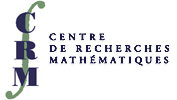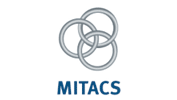 |
|
||||
Org: Christof Geiss (UNAM) and Arturo Pianzola (Alberta)
[PDF]
- DIANA AVELLA, UNAM, Av Universidad 3000, Coyoacan, Mexico City, Mexico
Combinatorial approach to the derived classification of gentle algebras [PDF] -
An interesting family in representation theory is the one consisting of gentle algebras. This family is closed under derived equivalence by a result of Schröer and Zimmermann; because of the way in which these algebras are defined they can be described and manipulated in a very easy combinatorial way, in order to understand their derived equivalence classes. We will discuss the results obtained for gentle algebras of two cycles and some generalizations for gentle algebras with more than two cycles, by using this combinatorial approach.
- CLIFTON CUNNINGHAM, University of Calgary
Character sheaves over local fields: the example SL(2) [PDF] -
Although character sheaves were devised with representations of finite groups of Lie type in mind, character sheaves are perfectly well defined for reductive algebraic groups over any algebraically closed field. Nevertheless, the relation between character sheaves of an algebraic group G over an algebraic closure of a field K and characters of representations of G(K) is well understood only when K is a finite field and when K is the field of complex numbers.
In joint work with Hadi Salmasian, we consider the case when K is a non-Archimedean local field and explain how to match certain character sheaves of an unramified connected reductive algebraic group G with virtual representations of G(K). In this talk I will illustrate this connection by treating the example G = SL(2) over the p-adic field K = Qp. In the process we will see lovely relations between certain character sheaves of SL(2) over [`(Q)]p and L-packets of admissible representations of SL(2,Qp).
Joint work with Hadi Salmasian.
- JOSE ANTONIO DE LA PEÑA, Universidad Nacional Autónoma de México
The information in the coefficients of a Coxeter polynomial [PDF] -
Let A be a finite dimensional algebra over an algebraically closed field, assume that A has finite global dimension. Let p(t) = a0 + a1 t + a2 t2 + ¼+ an tn be the Coxeter polynomial of A. If A is connected then a0=1=an, and Happel has shown that a1 is the alternating sum of the dimension of the Hochschild cohomology groups of A. We build a large family of algebras where a2=1 happens exactly when A is derived equivalent to a hereditary algebra of type An.
- PEDRO LUIS DEL ANGEL, Centro de Investigacion en Matematicas A.C.
Motives of Grassmannian Bundles [PDF] -
We will briefly recall some properties which are common to several cohomological theories when applied to smooth projective varieties, to motivate Grothendieck's search for a theory of motives. Then we will recall the definition of chow groups of a smooth projective variety and the definition of Chow Motives, with some explicit and simple examples, in particular we will work out the motive of a projective bundle and then will say what the motive of a Grassmannian Bundle should be.
Some of the results in this talk were obtained by my student Carlos Pompeyo in his Ph.D. thesis.
- CHRISTOF GEISS, Instituto de Matematicas, UNAM, Ciudad Universitaria, 04510 Mexico D.F., Mexico
Tubular Cluster Algebras [PDF] -
We present a categorification of four mutation finite cluster algebras by the cluster category of the category of coherent sheaves over a weighted projective line of tubular weight type. Each of these cluster algebras which we call tubular is associated to an elliptic root system. We show that via a cluster character the cluster variables are in bijection with the positive real Schur roots associated to the weighted projective line. In one of the four cases this is achieved by the approach to cluster algebras of Fomin-Shapiro-Thurston using a 2-sphere with 4 marked points whereas in the remaining cases it is done by the approach of Geiss-Leclerc-Schroer using preprojective algebras.
- JULIA GORDON, University of British Columbia
Motivic Integration and local integrability of characters [PDF] -
Let K be a local field, G a reductive group over K, and p a representation of G. A theorem due to Harish-Chandra asserts that there is a locally constant function defined on the set of regular elements in G, which is also locally in L1, that represents the distribution character of p. This function is commonly referred to as the character of p. Harish-Chandra's theorem assumes that K has characteristic zero. In positive characteristic, it is known that the character function exists and is locally constant, but it is not known whether it is locally integrable. We show that for a large class of representations of symplectic and special orthogonal groups, the character is in a class of functions called "constructible motivic exponential functions"; this class is defined by means of logic.
As an application, for these representations we can conclude that the character is a locally L1 even if K is of positive characteristic, as long as the residue characteristic is large.
This is joint work with Raf Cluckers, Clifton Cunningham, and Loren Spice.
- NICOLAS GUAY, University of Alberta, Edmonton, AB, Canada
Representations of double affine Lie algebras [PDF] -
After introducing Lie algebras attached to a rank one rational Cherednik algebra, I will present results related to three kinds of representations of such algebras: integrable highest weight modules, Weyl modules and quasi-finite highest weight modules. In the first and third cases, I will present a criterion for integrability and quasi-finiteness, whereas, in the second case, I will give lower bounds for the dimension of certain Weyl modules.
- JOCHEN KUTTLER, University of Alberta
Schubert varieties [PDF] -
Schubert varieties-B-orbit closures in G/B-play an important role in algebraic geometry, representation theory, and combinatorics.
In this talk we will study the question, how to determine the singular locus of a given Schubert variety in the case of G semisimple, and discuss some partial results for the affine (loop) Grassmannian.
Various parts are joint work with J. Carrell and V. Lakshmibai.
- MICHAEL LAU, University of Windsor
Representations of Multiloop Algebras [PDF] -
Given any complex Lie algebra L, the current algebra Map(T,L) of L-valued regular functions on the n-torus T is a Lie algebra with pointwise Lie bracket. When T and L admit the action of a discrete group G, the G-equivariant functions in Map(T,L) form a Lie subalgebra. We will discuss some examples of such algebras and their representations.
- ALFREDO NÁJERA, Universidad Nacional Autónoma de México, Av. Universidad, 3000 México D.F.
Coefficients dynamics of the Markov cluster algebra [PDF] -
We study the cluster algebra with principal coefficients arising from the torus with one puncture, which sometimes is called the Markov cluster algebra. We describe the coefficients in terms of triples of rational numbers which parametrize the exchange matrices.
- ERHARD NEHER, University of Ottawa
Finite-dimensional irreducible representations of equivariant map algebras [PDF] -
Consider an affine algebraic variety X and a finite-dimensional simple Lie algebra L, both equipped with an action of a finite group by automorphisms and both defined over an algebraically closed field of characteristic 0. The equivariant map algebra associated to these data is the Lie algebra consisting of the equivariant maps from X to L. Examples of equivariant map algebras are (twisted or untwisted) multiloop algebras, current algebras, n-point Lie algebras, and the Onsager (Lie) algebra.
In this talk I will describe finite-dimensional irreducible representations of equivariant map algebras.
The talk is based on joint work with Alistair Savage and Prasad Senesi.
- FERNANDO SZECHTMAN, University of Regina
Modular reduction of the Steinberg representation of the general linear group [PDF] -
Shortly after Chevalley constructed his groups of Lie type in a uniform manner, Steinberg did the same for his representation. In characteristic 0 it is always irreducible and realizable over Z. Reduction modulo a prime different from the defining characteristic need no longer be irreducible and, in fact, may be quite far from being so.
In the present talk we will examine the case of the general linear group GLn(q) with the aim of finding of finding a composition series for St when reduced modulo a prime l that does not divide q.
It is conjectured that a natural filtration for this reduction, namely its Jantzen's filtration, is actually a composition series. Our presentation will focus on recent progress regarding this conjecture.






